Three years ago, Shelterforce covered the stories of a handful of community development organizations that had begun work under multi-million dollar grants from ArtPlace. The grants gave housing and social service providers an opportunity to explore whether they could further their missions by integrating arts and culture strategies into their work. This is the final piece in a series of articles that follow up on the three organizations we featured.
Finding affordable housing has long been a challenge in Southcentral Alaska, where the cost of building in cities like Anchorage is high and the housing inventory is low. As a result, many families struggle to find housing to buy or rent.
One organization that has been working to help those families is the Cook Inlet Housing Authority (CIHA), a tribally designated housing entity in Anchorage. Established in 1974 to help provide affordable rental housing for seniors, CIHA evolved to focus on family rental housing development and later to help low- and moderate-income households buy homes. Over the years it has expanded its services beyond housing to include initiatives to improve health and wellness and financial fitness in the community. Most recently, CIHA’s vision of empowering the community has expanded to encompass art.
In 2015, CIHA was one of six organizations selected to receive $3 million over three years through a Community Development Investments (CDI) grant from ArtPlace America. The grant enabled CIHA and other grantees to integrate arts and culture strategies into all facets of their work and operations. In 2017, Sezy Gerow-Hanson, CIHA’s director of public and resident relations, told Shelterforce the organization was looking not only to figure out how to forge new partnerships in the arts and culture sector and prioritize creative placemaking as a development strategy, but also to find ways to make these practices sustainable beyond the grant period.
CIHA chose to focus most of its work in the Spenard neighborhood of Anchorage. Victor Rubin, senior fellow at PolicyLink—a racial and economic equity research and advocacy institute that partnered with ArtPlace to measure the impact of the grant and document how arts engagement affected each grantee’s community development work—describes Spenard as “an interesting, kind of funky, Bohemian place that has always had a challenge having enough public investment in the roads and in the buildings and in the people there.”
Learning to Speak a New Language
From the beginning of the grant, ArtPlace made it clear that experimentation was the top priority; it was OK to fail. “We had a failed call for artists for a project and we had learning in that failure,” says Gerow-Hanson. “As people who don’t like to fail, it was a new concept for us, but we definitely looked at those learning moments and those became some of our most cherished aha moments.”
As CIHA staff began initial conversations with local artists, they weren’t sure how to explain what they were looking for in artist collaborations.
“We were not able to articulate very well what our goals were in a way that was exciting or relatable to the artists,” says Gerow-Hanson. “The language of housing development and the language of artists were totally different. We were in the same room, but it was as if we were speaking foreign languages.”
That challenge was echoed by artists Becky Kendall and Enzina Marrari. Marrari, a visual and performance artist, and Kendall, a choreographer and visual artist, agreed that when they heard about CIHA’s call, they wanted to work with the organization to “do something that had a broad community impact,” says Marrari. But after pitching several project ideas that all failed to get approval, Kendall and Marrari were frustrated. They agreed to try one more approach before walking away.
Gerow-Hanson recalls meeting with Kendall and Marrari and notes that after a couple of meetings, CIHA knew they wanted to work with them, but the ideas the duo had submitted thus far had not helped to address a community challenge.
At their next meeting, instead of presenting ideas, Kendall and Marrari asked CIHA staff what problems they thought might be solved with a creative approach.
[Related: Integrating Arts and Culture in Transit Plans]
“One community challenge was that there was going to be major roadwork just up the road from where we operate,” Gerow-Hanson says. That region was a major business corridor. CIHA thought it could use art to bring attention to the corridor and put a positive spin on the reconstruction project while also providing support to the local businesses that would be affected. “Everybody knows when there’s major roadwork people avoid the entire area so the idea was how do we help support those small businesses during this road construction project so people continue to support them.”
At one meeting between Kendall, Marrari, and CIHA staff, Gerow-Hanson noticed a lone mime standing outside the window. “We didn’t have any idea what that was about but we were fascinated that there was a mime out there and then the artists said, ‘that’s our mime and that’s our idea.’ We were smitten.”
Mime Spenard
The Mime Spenard Project treated residents to an increasing number of mime performances along the Spenard Road corridor as road construction progressed. Business owners and residents marveled at seeing one mime, then a smattering of mimes, and later dozens of mimes performing on the street. For the finale of the project, called Mime Day, residents had the opportunity to have their faces painted and learn how to mime, and local businesses got in on the act; some worked with Marrari and Kendall to host mimes in their stores.
“It captivated the imagination of the community,” says Gerow-Hanson. “I think most of the businesses thought it was fantastic that someone cared enough to create a spectacle that might bring them business. And that was really a fun way for us to partner with the community.”
The breakthrough Marrari and Kendall had with CIHA came down to two things, says Marrari. “I think it was them being able to articulate the problem, but also us being open to throwing away any preconceived idea we had. We went from having this great idea that we think the community needs, to saying, ‘what’s the problem, what can we help with?’”
Kendall agrees. “Artists don’t always think of themselves as problem solvers, but that is what we do all day in any type of project we work on. Shifting ourselves into that mindset made it easy after that.”
- Photo courtesy of the Cook Inlet Housing Authority
- Photo courtesy of the Cook Inlet Housing Authority
- Photo courtesy of the Cook Inlet Housing Authority
- Photo courtesy of the Cook Inlet Housing Authority
- Photo courtesy of the Cook Inlet Housing Authority
- Photo courtesy of the Cook Inlet Housing Authority
- Photo courtesy of the Cook Inlet Housing Authority
Smoothing the Road for Creation
A major lesson CIHA learned while working with Kendall and Marrari was the importance of identifying a community challenge that a potential creative project would attempt to solve. “If we’re able to sit at a table collaboratively with artists and we all understand how we’re identifying and defining that community challenge then the rest of the process is likely to work really smoothly,” Gerow-Hanson says. “If we’re not able to immediately identify the community challenge then I think we’re not going to be successful.”
CIHA also had to learn more about how artists work and how they like to be treated. For example, a had to learn how to value an artist’s time. “If you’re engaging an artist and they’re going to put a lot of hours in, what is the right amount to pay them over the course of that time,” says Tyler Robinson, CIHA’s vice president of community development, real estate, and planning.
To help them price projects, CIHA tapped its growing network of artists and other creatives and asked them for their input. CIHA would describe a potential project and provide a ballpark of how many hours they thought an artist would spend fulfilling the objectives. The creatives would then agree or push back, saying such a project would likely take more or less time.
Many of the projects ended up costing in the $30,000 to $50,000 range, Robinson says. Without the ArtPlace grant, it would likely have been difficult to convince the organization’s leadership to approve an art project with such a high price tag. “We as a society are not used to valuing art at the level that we’re doing it,” Robinson says. “If you go to your board and say ‘we’re going to do a $40,000 project,’ they say ‘that’s a lot of money.’ But if you say ‘I’m going to hire a bookkeeper this year,’ they’re more likely to say OK.”
Then there were organizational barriers. For example, when CIHA worked with general contractors in the past, those businesses had to be licensed, bonded, and insured. But artists don’t get licensed or bonded so CIHA had to amend its policies to allow for these new partnerships. “We have policies and procedures and those aren’t going away, but we had to ask ourselves if they could be changed so that a single artist is able to more easily partner with us,” Gerow-Hanson says.
“Within an organization like ours, change is not done super quickly,” says Robinson. “We’re not an organization of four to five people that can just quickly say ‘this is what we’re doing now.’ We have to get buy-in all the way down to our comptroller or procurement person.”
Embracing a New Way of Working
After Mime Spenard, coming up with new projects was no less challenging for CIHA, but its participation in several creative placemaking convenings provided education and inspiration. “ArtPlace really helped us to define the practice of creative placemaking and that very first step of identifying the community challenge,” Gerow-Hanson says.
In CIHA’s earliest days of working with artists, it sought to use art to solve problems around its properties or the neighborhoods it worked in. But after witnessing artists’ skill at creating authentic engagement within a community, staff wanted to explore how they could insert an arts approach within the organization itself.
“We asked ourselves, ‘How could artists and creatives help us internally,’” Gerow-Hanson says. It didn’t take long for them to come up with an answer: “We have to be better at articulating the challenges around affordable housing … and in order to do that in a compelling manner, we needed to be better storytellers.”
An initiative called Creating Community Through Art seeks to use creative activities to pique the interest of members of the community and draw them in. Community members may be more likely to come out for a dance class or a finger-painting session than for a community forum.
Once community members are engaged in a creative activity, CIHA staff members can take the opportunity to tell their story, or talk about ways to increase affordable housing opportunities. They can also ask participants about issues that are most important to them.
Whether CIHA is hosting a drawing or painting or pottery workshop, “you’re doing an activity together, you’re building relationship and then you’re able to ask someone a question about their neighborhood that maybe you wouldn’t normally ask in a first conversation,” Gerow-Hanson says. “That’s really helpful to us.”
Using Arts to Promote Affordable Housing
An ongoing challenge of CIHA’s was finding enough physical space on which to build. One solution it had been working on was decreasing the size of some of its one-bedroom housing units. To help brainstorm how to make smaller units practical, CIHA hired set design artist Sheila Wyne to work with its construction team. The group created a 280-square-foot micro-unit studio apartment with movable furniture so staff members, community members, private developers, and legislators could all better envision how adopting micro-units might relieve some of the housing strain.
The project, called Living Big Living Small, became a powerful educational tool for stakeholders and was instructional for CIHA. “Incorporating a set designer and doing something at full scale just flipped our thinking and in the end, it was more than just coming up with a good layout. It was all of the discussion with all of the different groups that we interacted with around what it means if you live in a small space and what you need in your community to make that successful.” For example, the need for plenty of recreation space in the surrounding neighborhood was more apparent when one was able to physically stand in a true-to-life-sized model of a small unit.
Using Arts to Bridge Communities
Art also helped CIHA transform its relationship with the community.
In 2013, before the CDI grant was awarded, the Cook Inlet Housing Authority bought a church building and land near its headquarters with the intention of tearing the building down to use the land for parking. In 2015, before those plans could be implemented, a local art collective asked if it could use the space for the celebration of the Anchorage Centennial, and CIHA agreed. “For artists to show us that this building in its current form had a lot of value and could serve a different purpose was really an incredible experiment to us,” Gerow-Hanson says.
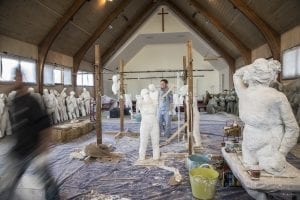
Artist works on stone body casting in the former Church of Love site. Photo courtesy of Michael Conti
That was the beginning of an expanded relationship with the local arts community and it was happening just as the CDI grant was being awarded. It made sense for the building, which came to be called the Church of Love, to become a focal point of the organization’s efforts to explore new ways for arts and culture to be used for community development under the grant.
During the CDI grant period, the Church of Love was used as a performance venue for local artists as well as a gathering place. It’s also the creative home to six studio artists.
“The artists that are renting the studios really activate the space,” Gerow-Hanson says. “If you think about an old defunct boarded-up building now having a life in a 24/7/365 kind of way, it brings more vibrancy to a neighborhood. It’s alive and there’s investment and commitment and I think that’s good for the whole street and the whole neighborhood.”
Applying Lessons and Moving Ahead
With the CDI grant ending at the end of 2018, the challenge to CIHA incorporating arts-inspired strategies into its work is funding. Its regular sources of funding are largely focused on the development and operation of affordable housing, and not very flexible. “Where do we find funding to support having an artist-in-residence program?” says Gerow-Hanson.
Not only has CIHA seen a value in partnering with artists, but its efforts have been recognized outside of the organization. In 2018, CIHA was awarded a 2018 Award of Excellence in Affordable Housing by the National Association of Housing and Redevelopment Officials for the 3600 Spenard development, a 33-unit mixed-use building in Anchorage. A write-up about the award in the Journal of Housing & Community Development described how CIHA incorporated art into the project. Local artists designed a storyboard and benches for a site that honored the Alaska Natives who originally lived in that particular region.
“Under the umbrella of community development, the partnership with artists has a really nice fit,” Gerow-Hanson says. “We still have to find separate funding dollars to work that practice but through these three to four years of doing this work, we’ve met some of those partners who are interested in this cross-section and we’re able to continue looking for grant money to support that.”
Robinson agrees that the expanded view allows CIHA to look to new markers of success. “We’re not going to solely measure our outputs in housing units,” he says.
They plan to continue exploring different opportunities for creative placemaking and to build an artist-in-residence program.
“We think an artist-in-residence program can help us connect and make stronger relationships within neighborhoods, which in the end makes a better outcome for the work that we do as housing developers,” Gerow-Hanson says.
The three-year project turned out to be a success for all—CIHA, the artists, and the Spenard community. Marrari is not surprised. “Art creates a really accessible, disarmed way for people to come together and create connection with each other over a shared experience,” Marrari says. “It engages a certain part of the brain that I think we forget about interacting with in our daily lives and brings back that spark of joy.”




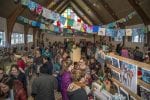



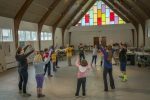


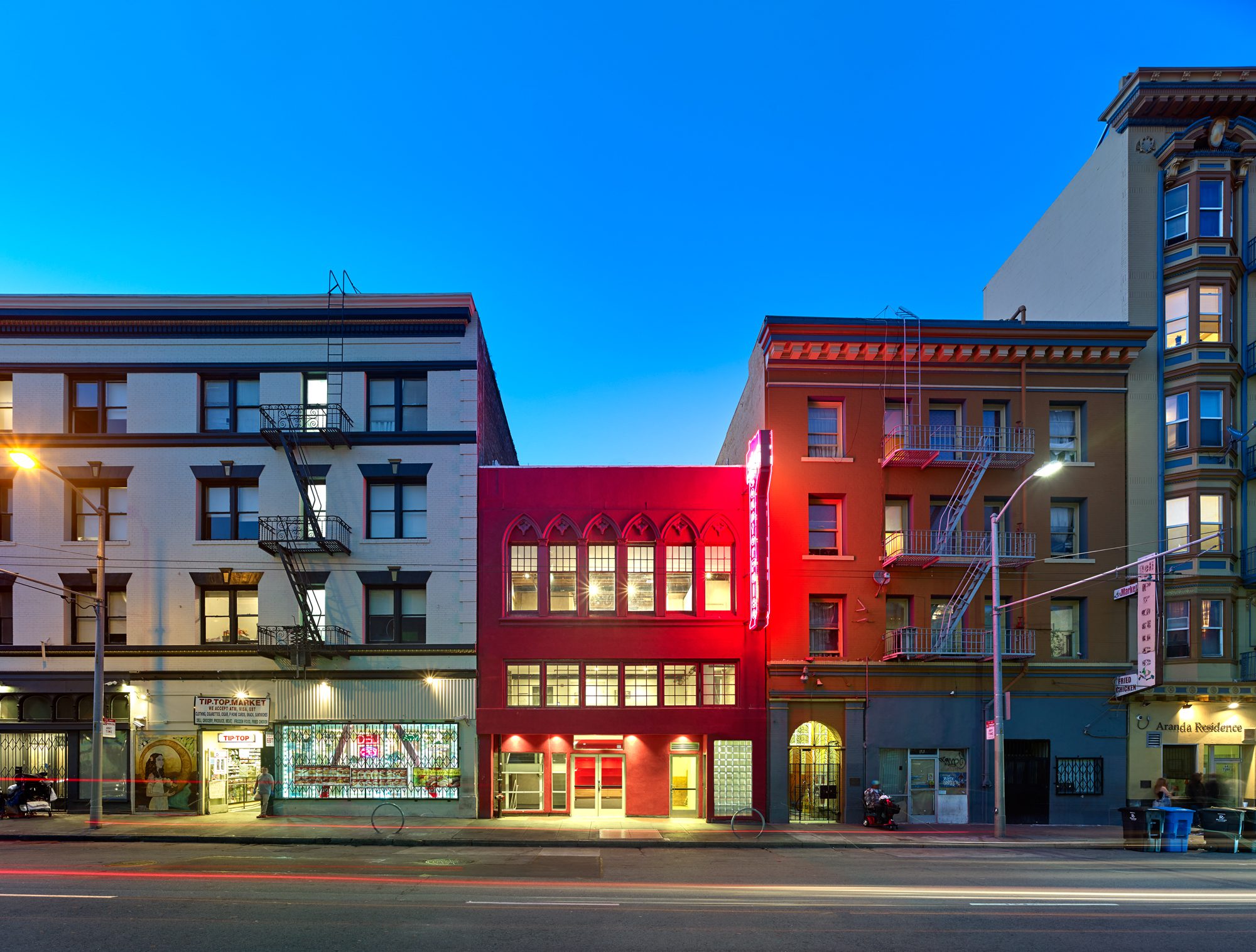
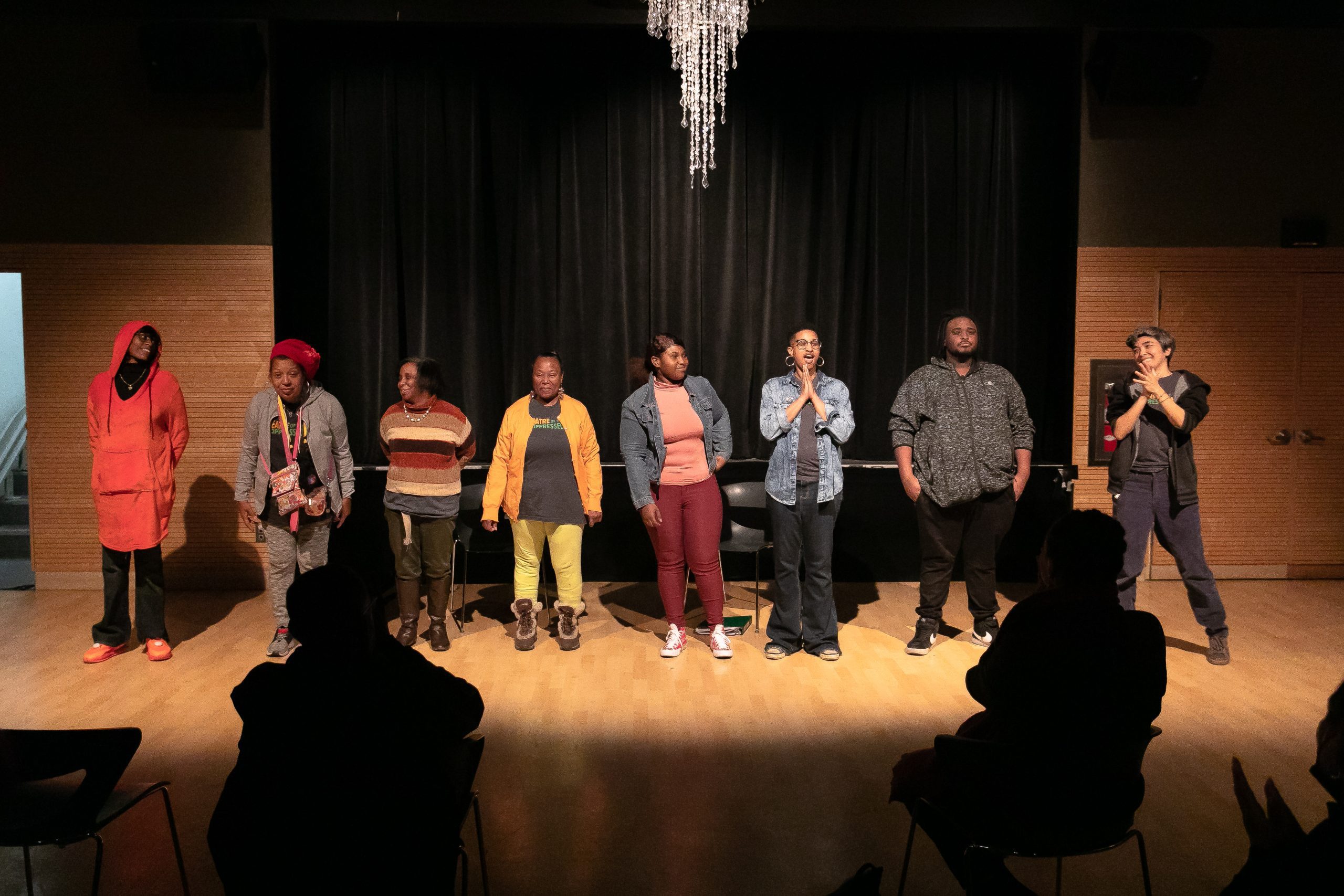
Comments